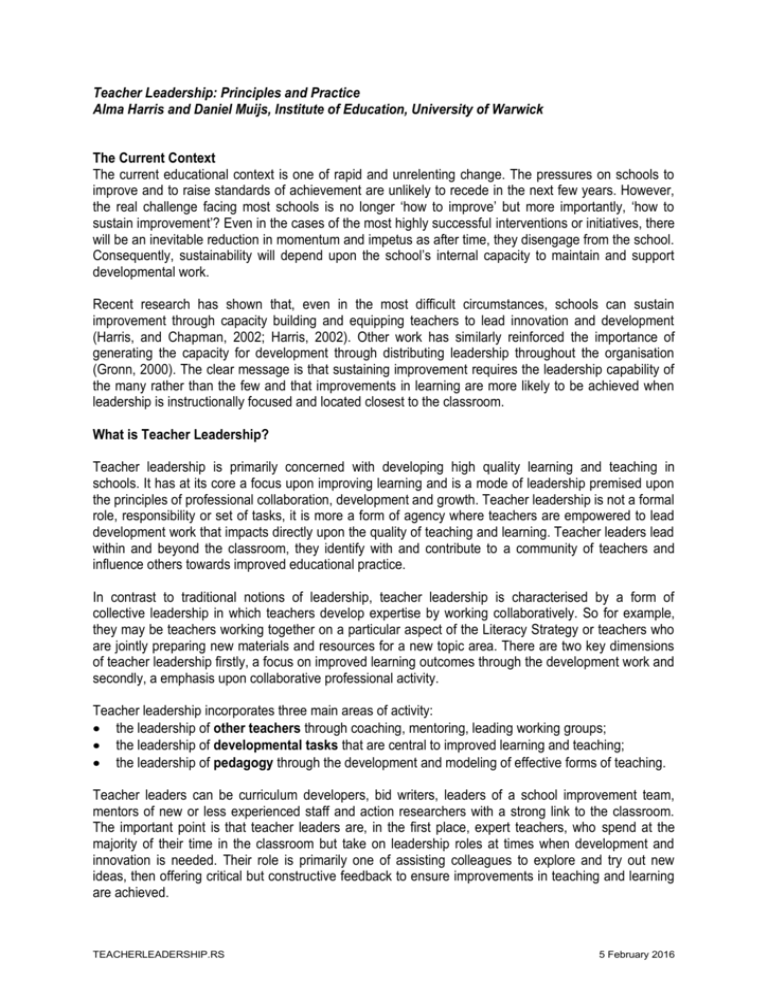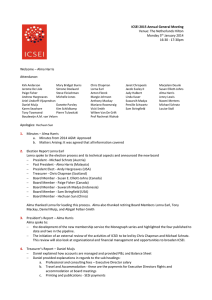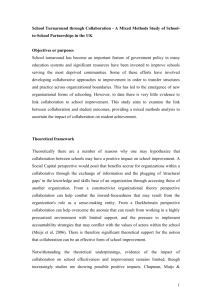What is teacher leadership
advertisement

Teacher Leadership: Principles and Practice Alma Harris and Daniel Muijs, Institute of Education, University of Warwick The Current Context The current educational context is one of rapid and unrelenting change. The pressures on schools to improve and to raise standards of achievement are unlikely to recede in the next few years. However, the real challenge facing most schools is no longer ‘how to improve’ but more importantly, ‘how to sustain improvement’? Even in the cases of the most highly successful interventions or initiatives, there will be an inevitable reduction in momentum and impetus as after time, they disengage from the school. Consequently, sustainability will depend upon the school’s internal capacity to maintain and support developmental work. Recent research has shown that, even in the most difficult circumstances, schools can sustain improvement through capacity building and equipping teachers to lead innovation and development (Harris, and Chapman, 2002; Harris, 2002). Other work has similarly reinforced the importance of generating the capacity for development through distributing leadership throughout the organisation (Gronn, 2000). The clear message is that sustaining improvement requires the leadership capability of the many rather than the few and that improvements in learning are more likely to be achieved when leadership is instructionally focused and located closest to the classroom. What is Teacher Leadership? Teacher leadership is primarily concerned with developing high quality learning and teaching in schools. It has at its core a focus upon improving learning and is a mode of leadership premised upon the principles of professional collaboration, development and growth. Teacher leadership is not a formal role, responsibility or set of tasks, it is more a form of agency where teachers are empowered to lead development work that impacts directly upon the quality of teaching and learning. Teacher leaders lead within and beyond the classroom, they identify with and contribute to a community of teachers and influence others towards improved educational practice. In contrast to traditional notions of leadership, teacher leadership is characterised by a form of collective leadership in which teachers develop expertise by working collaboratively. So for example, they may be teachers working together on a particular aspect of the Literacy Strategy or teachers who are jointly preparing new materials and resources for a new topic area. There are two key dimensions of teacher leadership firstly, a focus on improved learning outcomes through the development work and secondly, a emphasis upon collaborative professional activity. Teacher leadership incorporates three main areas of activity: the leadership of other teachers through coaching, mentoring, leading working groups; the leadership of developmental tasks that are central to improved learning and teaching; the leadership of pedagogy through the development and modeling of effective forms of teaching. Teacher leaders can be curriculum developers, bid writers, leaders of a school improvement team, mentors of new or less experienced staff and action researchers with a strong link to the classroom. The important point is that teacher leaders are, in the first place, expert teachers, who spend at the majority of their time in the classroom but take on leadership roles at times when development and innovation is needed. Their role is primarily one of assisting colleagues to explore and try out new ideas, then offering critical but constructive feedback to ensure improvements in teaching and learning are achieved. TEACHERLEADERSHIP.RS 5 February 2016 Why Teacher Leadership? The collaboration and collegiality fostered through teacher leadership has been shown to lead to an enhanced capacity for change and improvement at the school and classroom level. A variety of studies have found clear evidence of the positive effect of teacher leadership on teachers’ self-efficacy and levels of morale (Little, 1995). Research also shows that teachers who work together in a meaningful and purposeful way are more likely to remain in the profession because they feel valued and supported in their work (Beane 1998; Barth 1999). Research has consistently underlined the contribution of strong collegial relationships to school improvement and change. Collaboration is at the heart of teacher leadership, as it is premised upon change that is undertaken collectively. For teacher leadership to be most effective it has to encompass mutual trust, support and enquiry. Evidence suggests that it is difficult for teachers to create and sustain the conditions for improved pupil learning if those conditions do not exist for their own learning (Silns and Mulford, 2002). Where teacher share good practice and learn together the possibility of securing better quality teaching is increased. How to foster teacher leadership? One of the main barriers to teacher leadership concerns the ‘top-down’ leadership model that still dominates in many schools. The possibility of teacher leadership in any school will be dependent upon whether the head and the senior management team within the school relinquishes power to teachers and the extent to which teachers accept the influence of colleagues who have been designated as leaders in a particular area. In order for teacher leadership to become embedded, heads will therefore need to become ‘leaders of leaders’ striving to develop a relationship of trust with staff, and encouraging leadership and autonomy throughout the school. To generate and sustain teacher leadership will require: - Empowerment and encouragement of teachers to become leaders and to provide opportunities for teachers develop their leadership skills; Time to be set aside for teachers leadership work, including time for professional development and collaborative work, planning together, building teacher networks, and visiting classrooms; Opportunities for continuous professional development that focuses not just on the development of teachers’ skills and knowledge but on aspects specific to their leadership role, such as leading groups and workshops, collaborative work, mentoring, teaching adults and action research. What’s in it for Schools and Teachers? Teacher leadership offers schools a way of engaging teachers in a meaningful and timely debate about professionalism and issues of professional conduct. Essentially, the concept of teacher leadership endorses the principle that all teachers have the skills, abilities and aptitude to lead and should be trusted to do so. Furthermore, it reiterates how teacher leadership contributes to raising pupil performance, is pivotal in generating collaboration between teachers and in securing professional learning communities both within and between schools. Where this occurs teachers are more likely to engage in high-level collaborative activities in order to improve their teaching capability and performance. TEACHERLEADERSHIP.RS 5 February 2016 The idea of teacher leadership is powerful because it is premised upon the creation of the collegial norms in schools that contribute directly to school effectiveness, improvement and development. Teacher leadership is also powerful because it gives teachers recognition for the diverse but important leadership tasks they undertake on a daily basis. It also reinforces how these leadership activities influence the quality of professional relationships and standards of teaching within the school. In short, teacher leaders make a significant difference to the learning experiences in classrooms. At a policy level, teacher leadership points towards a ‘new professionalism’ based upon mutual trust, recognition, empowerment and support. At its most practical it suggests a way of teachers working together in order to improve the learning experiences of young people. Note: The complete literature review appears on the GTC, NCSL and NUT web-sites Contributors’ Note Alma Harris is Professor of School Leadership at the Institute of Education, University of Warwick. She has published extensively on the theme of school improvement and leadership. She is currently working on a research programme funded by the GTC, NUT and NCSL exploring aspects of ‘Teacher Leadership’ Contact:alma.harris@warwick.ac.uk. Daniel Muijs is lecturer in Quantitative Research Methods at Warwick Institute of Education. Dr Muijs has conducted a number of large-scale research projects and and programme evaluations and has expertise in quantitative and qualitative research methods. Dr Muijs is co author of ‘Effective Teaching: Evidence and Practice’ (2001 with Reynolds, D.) London: Paul Chapman Publishing. Contact: R.D.Muijs@warwick.ac.uk References: Barth, R. S. (1999). The Teacher Leader. Providence, RI, The Rhode Island Foundation. Beane, J. A. (1998). "Reclaiming a Democratic Purpose for Education." Educational Leadership 56(2): 8-11. Gronn, P.(2000) ‘Distributed Properties: A New Architechure for Leadership Educational Management and Administration vol 28 no 3 p317-38 Harris, A. (2002) School Improvement: What’s in it for Schools?, London Falmer Press Harris, A and Chapman, C (2001) Democratic Leadership for School Improvement in Challenging ContextsA paper presented at the International Congress on School Effectiveness and Improvement, Copenhagen Little, J. W. (1995). Contested Ground: The Basis of Teacher Leadership in Two Restructuring High Schools. The Elementary School Journal, 96(1), 47-63. Silns, H. and Mulford, B. (2002) Leadership and School Results Second International Handbook of Educational Leadership and Administration, Kluwer Press TEACHERLEADERSHIP.RS 5 February 2016











